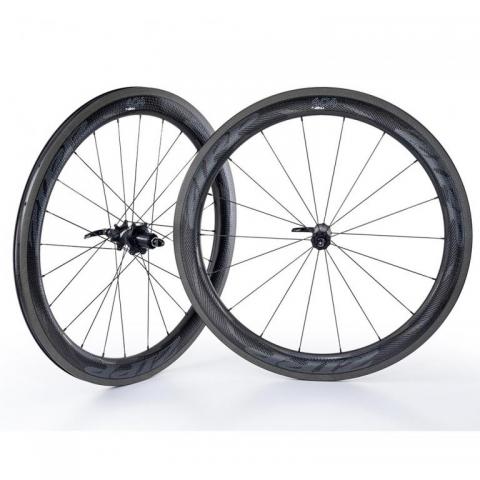Zipp 404 NSW Carbon Clincher Road Wheels
Zipp have continually impressed us with their inability to leave winning designs well enough alone. The 404 NSW Carbon Clincher Road Wheelset is the latest fruit of their restless tinkering, and it improves on the already impressively improved 404 Firestrike model. These improvements start with a claimed weight that's 65g lighter than the Firestrike equivalent and 135g lighter than the Firecrest. The improvements continue in three other key areas: aerodynamics (of course), the freehub, and braking. We'll get to the hub shortly but, this being Zipp, we're inclined to focus first on the rim.
The rims are equipped with an updated version of Zipp's Showstopper brake track, which enjoyed an impressive debut on the Firestrike 404 but has already been improved for the NSW model. It's still imbued with the same silicon carbide particles, but the direction-specific grooves have increased in number and changed in depth. The original Showstopper netted some pretty impressive stopping across all conditions, but Zipp assures us that the new version is even better. The upshot is you can hold speed longer while approaching a corner, braking later and gaining tiny increments of time with each bend or switchback. You can also, you know, stop reliably when obstacles like darting dogs, inattentive motorists, or run-off debris on a fast canyon descent make unexpected cameos in your ride.
The brand's signature Aerodynamic Boundary Layer Control (ABLC) dimpling returns with a new designation. It's called SawTooth Technology, and it consists of ABLC dimples applied in a single pattern repeated in 12 discrete swathes (or "nodes") across the rim's surface, looking much like the strokes of a paint brush. Zipp's description of SawTooth's effect is a bit, how shall we say, erudite, with the company claiming a 34% reduction in side wind forces compared to the previous Firestrike 404 by "reducing the laminar bubble effect on the aerodynamically shielded side of the rim's profile." Translated into saddle speak, that means while rolling at 20mph and above, the rim's dimpling is designed to dispel the negative, drag-inducing force on the rim's non-wind side.
SawTooth's premise stems from 42 computational fluid dynamics studies and testing that spilled out of the wind tunnel onto — gasp! — actual roads. In actual wind. You know, the conditions that we actual cyclists face every time we throw a leg over the top tube either side of trainer season. To help understand how SawTooth works, consider an aerodynamic NACA shape in the pristine wind tunnel conditions of zero-degrees yaw. When air resistance is perfectly head-on, drag only exists in a parallel plane with an object, so a teardrop NACA cross section reduces drag to its absolute minimum by reducing the wake. Turn the yaw angle upwards of 15 or 20 degrees, though, and a true NACA shape begins to experience drag from the side opposite cross wind pressure as well. This lateral drag is Zipp's "laminar bubble," and it's the phenomenon responsible for the violent instability that leaves us wrestling with our bikes on gusty days.
Though Zipp was one of the shape's early adopters, the industry is now replete with rounded, bullet-shaped rim designs that aim to lessen destabilizing drag from cross wind forces; however, if Zipp's numbers are any indication, the SawTooth nodes take that reduction to a whole new level by better controlling cross winds as they detach from the rim's opposite face. While deep rims will always be more vulnerable to lateral forces than shallow box clinchers, the Firecrest DSW's rim shape and SawTooth Technology contribute to a ride that requires less correction in windy conditions, and the corrections themselves are more subtle and intuitive than with yesterday's NACA profiles.
If this were any other Zipp wheel, that would be the end of the show; however, the new Cognition rear hub is every bit as innovative as the wheelset's rims. The hub is centered on Zipp's Axial Clutch mechanism, which features two Metal Injection Molding (MIM) ratcheting rings — one mated to the freehub body and one mated to the hub body. The two rings are machined like a ratchet, so they ramp off of each other while freewheeling but engage each other during pedal input.
Compared to a standard pawl design, which actually resembles a drum brake, the Axial Clutch's MIM rings engage laterally to reduce friction while freewheeling, so coasting doesn't negate watts already spent. We're familiar with this model, as we've seen similar mechanisms on the designer hubs featured in top-end custom builds for years now, but Zipp is the first to replace the usual tensioning agent, steel springs, with magnets. This substitution further reduces friction between the ratcheting rings, making for what may be the smoothest freewheel on any mass-produced hub set. It's a design that we suspect will eventually be the norm, but — once again — Zipp is leading the charge.















































